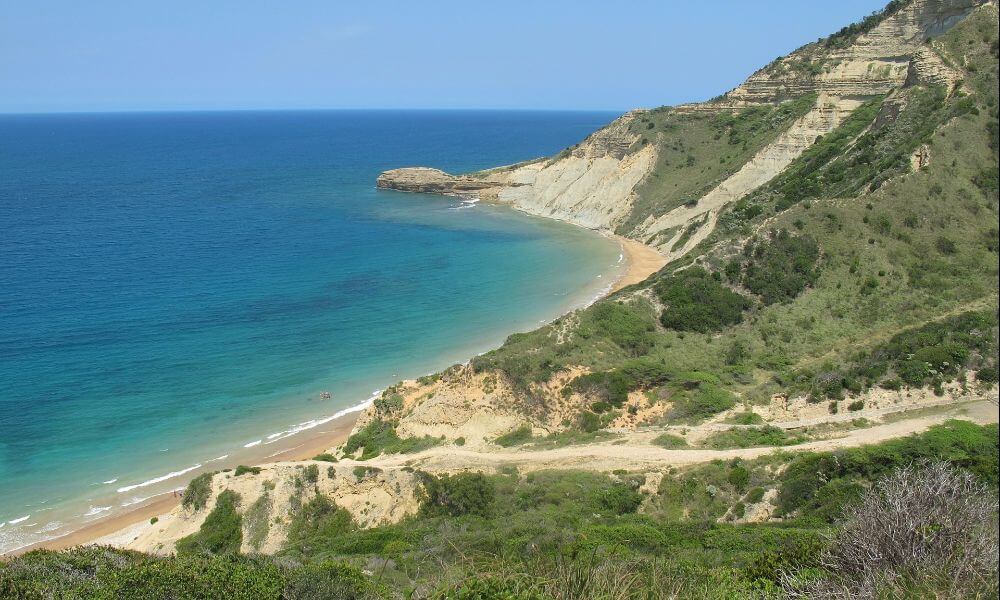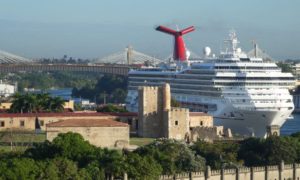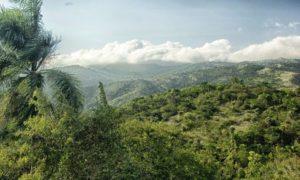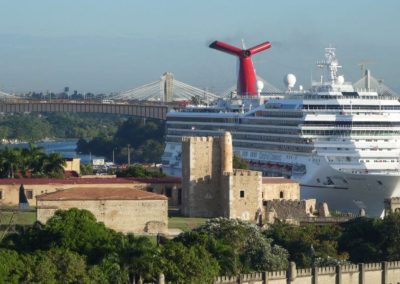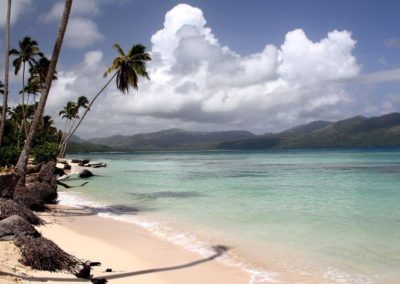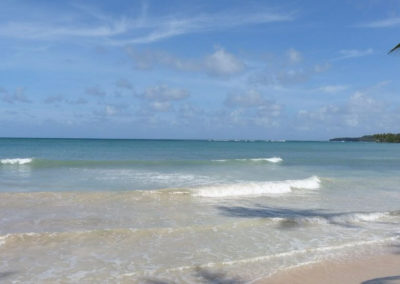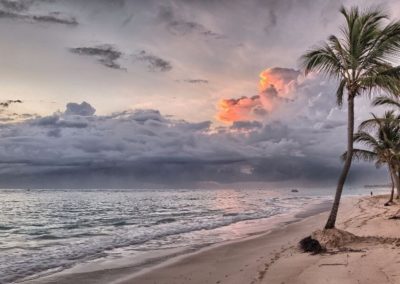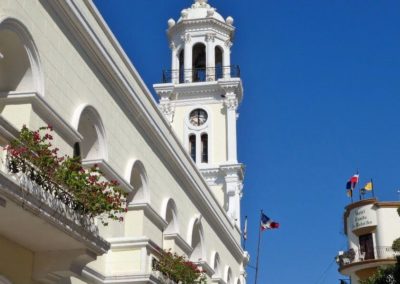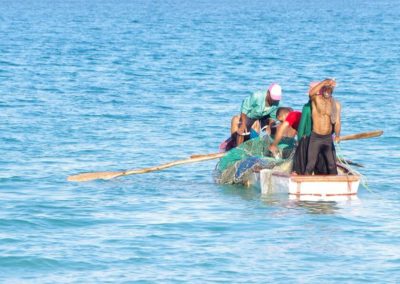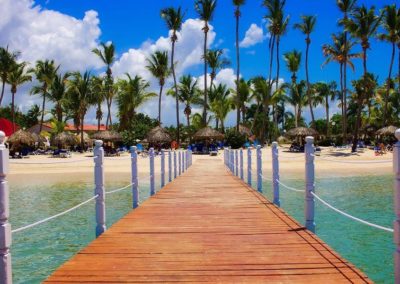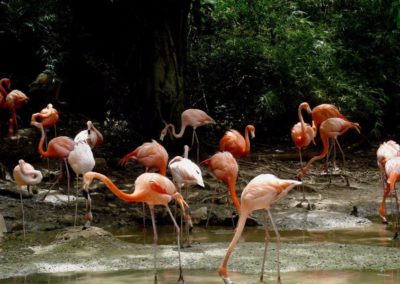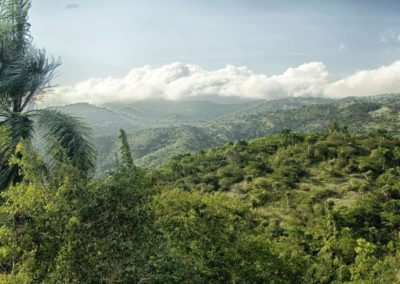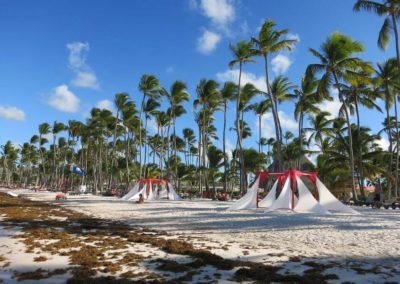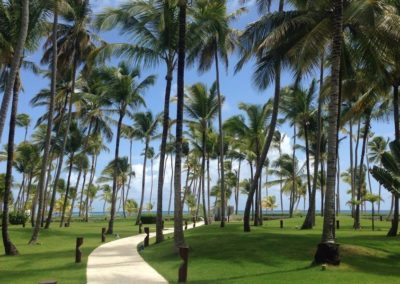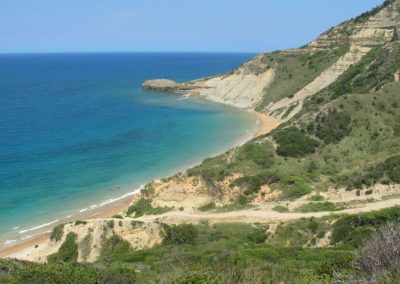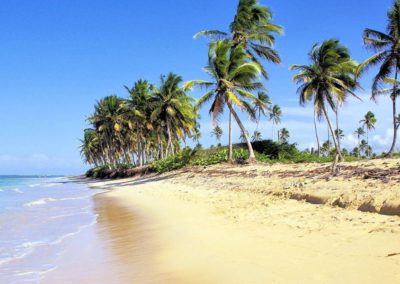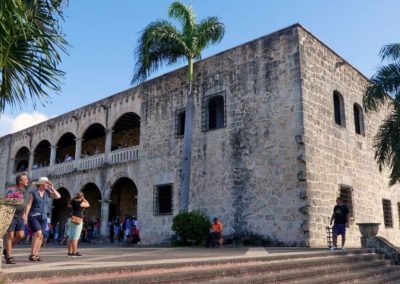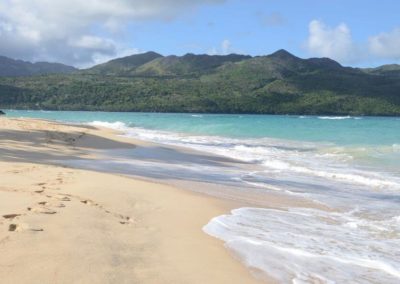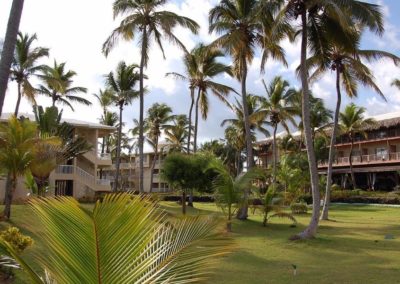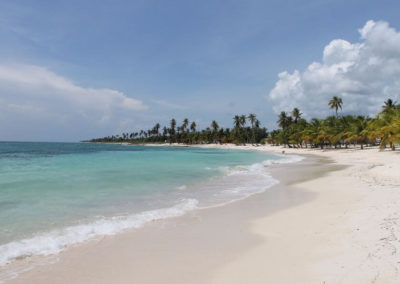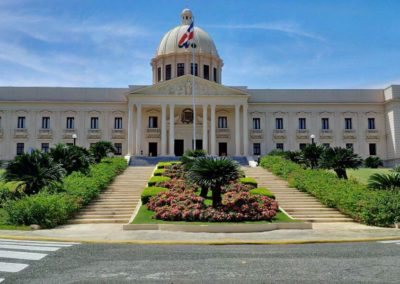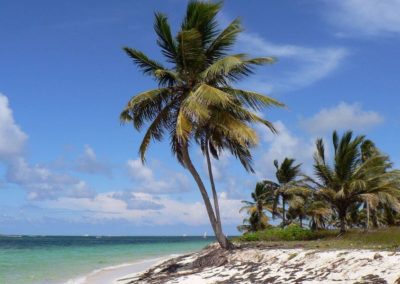Contents
Introduction
The Dominican Republic features remarkable sights and sounds, the warmth of the golden sun and the softness of white sand beaches, 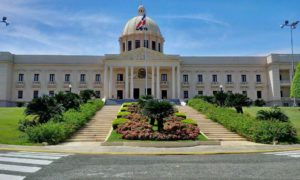 along a coast laced with exuberant tropical palm trees.
along a coast laced with exuberant tropical palm trees.
You will also experience the richness of the culture and history, a colonial past that earned Santo Domingo, a city designated as World Cultural Patrimony by UNESCO in 1990, the title Athens of the New World in the 16th Century.
Dominican Republic is known as the Caribbean vacation for the working man. That quickly might change as it is becoming fastest growing Caribbean island as far as tourism. Even with its emergence, it is still considered an incredibly cheap beach vacation especially if you consider that its in the Caribbean. Compare and contrast costs to Jamaica, Bahamas, Puerto Rico or Cayman Islands and you’ll know what I’m talking about.
Dominican Republic shares the island of Hispaniola with the neighboring country of Haiti. However, the two countries couldn’t be farther apart when it comes to hospitality and fun.
Being that the Dominican Republic is on the largest countries in the Caribbean, there is more than enough options for your dream beach vacation. Unlike many of the other Caribbean islands, which you can see the whole island in practically one day, the Dominican Republic is about the size of New Hampshire and Vermont put together. And the great news is that 1/3 of the coastline (well over 900 miles) has some of the most beautiful beaches, you’ll ever lay your eyes on.
On the north side of the island is one of the biggest areas for vacationers called Puerto Plata. By the Blue Bay Resort is the beautiful Playa Dorado. Five minutes in that warm, turquoise water is enough for a person to feel a constant state of Nirvana. The city is also very festive and you’ll have no time finding great restaurants, bars, and beautiful hotels.
On the very eastern tip of the island is the city of Punta Cana. If you are a fan of nature then you have to take a boat trip to Saona Island. 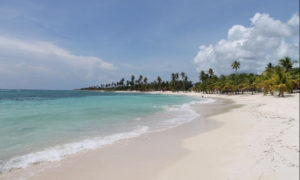 You’ll find all different kinds birds & animals in the wildlife park. You’ll also see countless fishes in the crystal clear water. You feel like you can just stick your hand in the water and grab a couple. It is strongly recommended that you take snorkeling tour as well. The water is so clear that you’ll fell like you’re in a swimming pool.
You’ll find all different kinds birds & animals in the wildlife park. You’ll also see countless fishes in the crystal clear water. You feel like you can just stick your hand in the water and grab a couple. It is strongly recommended that you take snorkeling tour as well. The water is so clear that you’ll fell like you’re in a swimming pool.
Towards the southeast is the city of La Romana. La Romana is geared more for the cosmopolitan crowd. There are tons of upscale resorts. There are also plenty of things to do when you’re not on the beach. You’ll find hundreds of tiny little shops around the city. There is also an incredible farmers market where vegetables, spices, meats, and anything else you can think of are sold.
Useful Links
- News and Travel Information – Largest and most visited site for the Dominican Republic. Visit Here
- Resort and Hotel Information – Awesome site for resort and hotel reviews. Check on Booking.com or Book an apartment via Airbnb and get $40 FREE CREDIT for your first trip.
- Legal Information – If it’s legal advice you need, this is the site. Run and owned by one the countries largest law firms.
- Dominican Cooking and Food – Everything you ever wanted to know about Dominican cooking and food. 100’s of recipes and packed with a ton of great info.
Useful information
Geography:
The Dominican Republic occupies the eastern two-thirds of the island of Hispaniola, which it shares with Haiti, and is the second largest 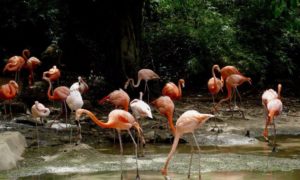 country in the Caribbean, comprising an area of 48,198 square kilometers (29,948 square miles). It is bordered on the north by the Atlantic Ocean and on the south by the Caribbean Sea. This is a big island by Caribbean standards and care should be taken to arrive at the one of four international airports that may be closest to your final destination to avoid long car trips, sometimes of up to eight hours for example if you land at Punta Cana International and are headed to Puerto Plata.
country in the Caribbean, comprising an area of 48,198 square kilometers (29,948 square miles). It is bordered on the north by the Atlantic Ocean and on the south by the Caribbean Sea. This is a big island by Caribbean standards and care should be taken to arrive at the one of four international airports that may be closest to your final destination to avoid long car trips, sometimes of up to eight hours for example if you land at Punta Cana International and are headed to Puerto Plata.
Population:
Approximately nine million people live in the Dominican Republic. Of these, one third live in the capital city and province of Santo Domingo.
Language:
Spanish is the official language of the Dominican Republic although English is widely spoken, especially in tourist areas and large cities. Knowledge of German, Italian and French is also common in resort towns. Traffic signs are in Spanish, although menus in tourist regions are usually available in several different languages.
Time:
The Dominican Republic is on Atlantic Standard Time all year long. Clocks are one hour ahead of those on the US eastern seaboard in the fall-winter but keep the same time in the spring-summer. The DR is four hours ahead of GMT time.
Electricity:
Appliances run on 110 volts/60 cycles, just as in the United States.
Weather:
As with the rest of the Caribbean, the most common weather forecast is partly sunny with a chance of a brief shower lasting 10 minutes or less, most likely in the late afternoon. The temperatures usually fluctuate from a high of 32?C (90?F) in August to a chilly 20?C (68?F) on winter mornings. Temperatures between summer and winter fluctuate less than ten degrees.
Taxes and service charges:
On arrival, most visitors are required to purchase a tourist card for US$10 and pay a US$20 departure tax at the airport upon departure. The US$10 charge permits a 15-day stay. For a stay of up to 90 days, an additional US$5 is assessed. Similar additional charges apply for longer stays.
Hotels collect 26% of their published prices (16% sales tax +10% service charge). Restaurants also charge the 16% sales tax and a 10% service charge but it is nevertheless customary to tip an additional 10% for satisfactory service in restaurants.
Santo Domingo
This enchanting metropolis combines modern sophistication, old-world charm and Latin flair. Santo Domingo (also known as the National District) has a population of one million, while another two million live in the environs of the province of Santo Domingo. With its vibrant nightlife, fashionable shopping districts and superb dining, the nation’s capital city brims with people, culture and history. A trip to Santo Domingo should be included in every visit to the Dominican Republic.
Boca Chica & Juan Dolio
Southeastern region strip featuring the beaches of Boca Chica, Caribe (Embassy), Guayacanes and Juan Dolio, all within a less than 20 minutes drive from each other. Several golf/residential communities have developed in the Guayacanes- Juan Dolio area and the beaches attract many residents from the nearby capital city of Santo Domingo, bringing about a boom in great restaurants from Boca Chica to Juan Dolio.
La Romana & Bayahibe
Casa de Campo put La Romana on the travel map since its start as a tropical golfer’s paradise in the 70s. Over the years, the destination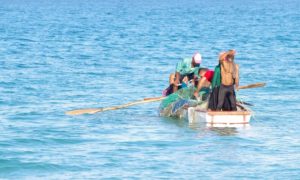 has only gotten better. To complement the outstanding golf facilities, yachtsmen and water sports buffs join horseback riders, weekend cyclists, tennis fans, hunters and skeet shooters alike who all enjoy mingling with the Dominican Republic’s jetsetters.
has only gotten better. To complement the outstanding golf facilities, yachtsmen and water sports buffs join horseback riders, weekend cyclists, tennis fans, hunters and skeet shooters alike who all enjoy mingling with the Dominican Republic’s jetsetters.
Visitors meet up with their friends who have migrated to their La Romana homes to escape the stress of big city life. The city was originally built around and maintained by the sugar mill years before tourism became the mainstay in this region. Even now, the seasonal production of sugar fills the air with the sweet smell of molasses and the design of the new La Romana International Airport mirrors a sugar cane mill. La Romana and Bayahibe today has just the right mix of right-on-the beach hotels, small restaurants and shopping to make for comfortable visiting and living. A prestigious Blue Flag certified beach, Bayahibe (Dominicus) is about a 20-minute drive from La Romana city, and is where most of the hotels are located.
Bavaro & Punta Cana
The 50-km eastern coastal stretch from Uvero Alto to the north, to Cap Cana along the East Coast of the Dominican Republic is for people of all ages who are primarily in search of rest and relaxation and water fun. Because of the lovely beach settings, weddings are frequent at resorts in this area. Most hotels in the area attract families, offering improved facilities every year for children of all ages. All-inclusive resorts prevail in this area, making for very carefree vacations. The area is becoming a mecca for US tourists, especially since Bill and Hillary Clinton chose Punta Cana in April 2001 as the site of their first sojourn after leaving the White House.
Samana
The most prominent geographic feature of the Dominican North Coast is the Samana Peninsula. Its extension out from the mainland of the country creates the magical bay of Samana, which attracts whale-watchers from around the world to observe the fantastic conclave of thousands of humpbacks in mid-January to mid March. Samana is a land where Europeans, who first came as tourists, have opened innumerable small hotels and restaurants. Samana is also the place to enjoy Dominican specialties, such as the delicious fish in coconut sauce. Sandy coves and white sand beaches run side by side with unexplored patches of tropical jungle, making for memories of paradise.
The North Coast
To the north, nestled along the more than 125-kilometer long Atlantic shore (from Monte Cristi to Playa Grande) is a thriving assortment of beach towns, resorts and communities. There, Dominicans and thousands of foreigners from dozens of countries have settled in over the past 100 years enticed by the relaxed lifestyle. Land of the rich deposits of the lustrous semi-precious amber, the north oceanside region is cradled by a chain of majestic coastal mountains. It was here that Columbus landed on his first voyage of discovery, and it is here where visitors will discover the same natural beauty and turquoise waters that enchanted the Genoese adventurer more than 500 years ago.
Jarabacoa & Constanza
The two inland cities of Constanza and Jarabacoa are the jewels in the crown of the Central Mountain Range, which comprises the tallest range in the Caribbean and is sometimes referred to as the Caribbean Alps. For a complete change of pace, the crisp air and alpine vegetation is every bit as enthralling as the beaches. Framed against intensely blue skies, they offer cooling respite from the coastal heat and an awesome visual panorama that unfolds in every direction.
Barahona & Pedernales
The tourism destination with the greatest biodiversity, the Barahona-Pedernales area of the country is the final frontier of local touristic development. Today domestic travelers and international connoisseurs of nature are its most frequent visitors. The striking natural attractions of this region are incomparable. This region boasts the largest lake in the Caribbean, a spectacular panoramic highway with vistas along the coast, a mountain parador that overlooks a remarkable chasm, scorchingly hot, dry forests that lie not far from pine tree forests, as well as being one of the most significant fruit-producing areas in the country.

